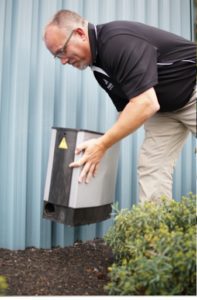Who is a member?
Our members are the local governments of Massachusetts and their elected and appointed leadership.

The city of Somerville has installed 50 SMART boxes to catch rats. (Photo courtesy city of Somerville)
Using an electrical current and real-time data tracking, the city of Somerville has embraced a modern approach to combat a centuries-old menace: rats.
A month ago, Somerville placed 50 SMART boxes in four areas as part of a five-month pilot program to reduce its rat population. As the second U.S. city to adopt this technology, after Portland, Maine, Somerville is using the boxes to electrocute the rats and collect data on them, and hopes the pilot effort will inform future rodent-control efforts.
Somerville officials said their approach offers a more humane and environmentally friendly solution to a problem vexing cities nationwide. The SMART boxes provide details about the number and locations of rats being captured.
When a rat enters a SMART box, the box senses movement and body heat and emits an electrical current. It then bags the dead rat, moves it into a compartment, resets automatically, and sends a signal about the capture. Each box can hold up to five rats at a time. Colin Zeigler, Somerville’s environmental health coordinator, said the boxes intercept rats along their usual paths, including along fence lines and other spots where rats feel less exposed.
“This isn’t necessarily just about killing rodents,” he said. “It’s more about data-driven approaches.”
Somerville declared a “War on Rats” back in 2013 and undertook several measures, including increased inspectional activity, public education and outreach, and the hiring of an environmental health coordinator. When Somerville’s new mayor, Katjana Ballantyne, named her immediate priorities on Jan. 3, her first day in office, she included rodent control among them.
“Yes, I just mentioned rats in my inaugural address,” Ballantyne said, adding that residents had regularly mentioned the problem during her mayoral campaign.
Somerville is far from alone. The U.S. Census Bureau reported last year that people living in 14.8 million of the country’s 124 million occupied units said they had seen mice or rats in the previous 12 months. In the bureau’s 2019 American Housing Survey, the Boston-Cambridge-Newton Metropolitan Area ranked second for rodent sightings among the country’s 15 most-populated areas. And the problem extends far beyond Greater Boston. In recent years, news reports have chronicled rodent complaints from the North Shore to southeastern Massachusetts, and from Cape Cod to the Berkshires.
According to Zeigler, Somerville received 928 rodent-related calls in 2019, 1,157 calls in 2020 and 1,172 last year. Some of the increased reporting owes to the city’s expanded outreach to residents, he said. In addition, people working from home during the pandemic threw out more trash there, attracting rats, and development projects have displaced rats into residential areas, he said.
According to the U.S. Centers for Disease Control and Prevention, rodents can transmit more than 35 diseases either directly or indirectly. They can also damage public infrastructure and private property, leaving behind chewed car wires and yards defaced with burrows.
“I see them as a problem, and not necessarily an enemy,” Zeigler said. “They’re just a species that has adapted to what we do, and they’re sort of living in our space. But they are a nuisance, and they do really harm the quality of life within a city.”
Somerville will pay $40,000 to cover the servicing, box rentals and data reporting by vendor Modern Pest Services. It chose the four pilot locations based on 311 complaints and inspectional services ticketing. According to the city, the diverse locations — including business and residential areas, open spaces, and locations close to construction and transit — will help the city gauge variables in rodent activity.
The boxes offer other advantages in that they avoid pesticides, and don’t leave toxins in the environment, Zeigler said. The Norwegian rat can squeeze through the small hole, he said, but other wild animals, pets and children can’t get into the locked devices, and the electrical components aren’t accessible from the outside.
Somerville started installation on Feb. 28, and got its first alert within 20 minutes, Zeigler said. By mid-March, the city had received 39 alerts of captured rats.
After the five-month pilot, Zeigler said he hopes the program can expand to other locations. The city may also consider placing boxes in its sewer system, he said.
Other communities have been considering similar efforts. At its April 4 meeting, the Cambridge City Council agreed to spend $50,000 on a pilot program that would involve the use of 40 to 50 SMART boxes, and 10 SMART pipes for the sewers, starting this spring. The city will undertake the pilot program on top of several initiatives it already has to control rats, including its Rodent Taskforce.
“I know this is such a huge issue in the community, and I know we’ve been doing everything that we can,” Cambridge Vice Mayor Alanna Mallon said at the meeting. “I hope this can be just another tool in the toolbox to fight the rat problem here.”
For more information about Somerville’s program, contact Colin Zeigler at czeigler@somervillema.gov.